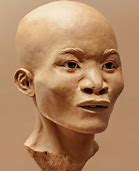Mariner watched a PBS Nova broadcast about the oldest evidence of a Native American in the Americas.[1] All of Nova’s broadcasts are above average not only in reporting historical information but in providing insights into those moments. “The First Face of America” matched that quality.
Much of the broadcast displayed the effort and luck of a group of scientists exploring the lattice of caves underlying the Yucatan Peninsula in Mexico. Today, these caves are underwater but 20,000 years ago at the end of the last ice age they were above sea level and dry. In fact, the Yucatan was exceptionally dry and early Americans often explored the caves looking for pools of water.
The great find was a complete skeleton of a sixteen-year old girl. Evidently she had entered a labyrinth in search of water and had fallen into a chasm. Carbon dating places her back 13,000 years and is the oldest evidence of humans in North and South America.
Evidently she had entered a labyrinth in search of water and had fallen into a chasm. Carbon dating places her back 13,000 years and is the oldest evidence of humans in North and South America.
Most of us know the general story of how humans crossed over what today is the Bering Strait and followed the coast through Alaska into North America. During the ice age, the Bering Strait was a large, dry plain between Russia and Alaska. It was larger than many may assume – ranging more than a thousand miles North to South. It has been given a regional name, Beringia, because it was a busy, continuously moving place for nomadic tribes following herds and hunting opportunities. Constantly moving, they left little in the way of artifacts.
The skeleton provided a lot of implications about the life of a sixteen-year old girl in a nomadic culture 13,000 years ago. The scientists gave her the name Naia. Naia was 4 feet ten inches tall and led a rough life we today could not tolerate. There was evidence of damaging rape, and likely a stillborn child; she had bone damage on her limbs one of which was a spiral fracture, meaning someone had twisted her arm violently. Insightful to her lifestyle was that her thigh muscles at age 16 were as large as those of an adult male today – evidence of day-in, day-out walking and running; certainly evidence of a nomadic hunter culture.
Mariner ponders how complex society could have been not having a sense of place. These nomads were always moving to find the next meal. There was no expectation of something called ‘home’ – not even for one night! Did these nomads ever feel lost? Probably not but it’s certain there were other anxieties.
Remember this was 13,000 years ago on an undiscovered continent. Civilization as we understand it had not hit its stride; the earliest evidence of semi-permanent civilization outside Africa was on the Fertile Crescent in the Middle East around 15,000 years ago.
So how well have humans fared over the years? Civilization certainly has learned how to be complex but rape and violence still abide.
Ancient Mariner
[1] On PBS at https://www.pbs.org/video/first-face-of-america-m6dgpn/
